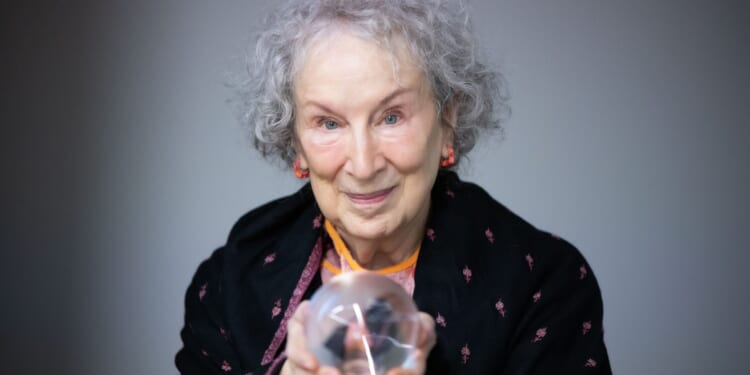Margaret Atwood has a reputation for spookily accurate predictions about the future of humanity in her novels. This is quite strange, because — as her new memoir Book of Lives demonstrates — she is in fact quite obtuse when it comes to interpreting humans. She doesn’t clock male romantic interest, even when obvious; is blindsided by rivalrous feuding in an independent publishing house of all places; can’t work out why so many “good-looking, well-dressed single women” would be sitting alone at Prague bars in 1984, and has to be told. When her father is gravely ill, she doesn’t “quite understand” why her mother goes to the hospital daily to play him his favourite Beethoven recordings: “Surely a couple of times a week would do.” Later, as her own partner lies dying, she finally gets the point.
She peppers her memoir with “why” questions, as if anxiously monitoring for things she might have missed. She also poses puzzled questions of her past self, though seems refreshingly untroubled by the answers. Of her temperament, she explains, “I was more interested in the paper people I could create than in doing deep dives into my own psyche, should such a thing exist”.
Being good at myth-making, the still fizzy 85-year-old seamlessly weaves her interpretative deficits into a vivid origin story: “One of my theories about novel writers is that they don’t know more about human nature than other people: they know less, and their novels are attempts to figure it out.” Her father was an entomologist; like him, she can’t stop mentally cataloguing bits of the world, then cross-referencing. “If I watched carefully, I’d be able to find out how stuff worked, whatever that stuff might be. Sometimes it was mechanical devices, such as sewing machines. But usually it was people.”
But though minds were slippery things to master, in other informational domains Atwood was in her element. She relished learning about arcane codes and ciphers, then applying them. She became able to identify rare fauna and flora, read palms, do star charts, detect ghosts. For a time she did graduate work in English literature at Harvard, but the role of critically minded theoretician didn’t seem to fit; her interest in the world is much more practical. She loves building novels out of images and ideas, just as she also likes making dresses, cakes, puppet shows, comic strips, operettas, poems and jokes.
Though it isn’t clear where all that creativity came from, the practical bent appears to have been non-negotiable during an extremely adventurous childhood. Book of Lives cheerfully describes a dangerous existence in the company of intrepid parents and an older brother: living in remote parts of Quebec and Ontario, sleeping in tents, surviving near-drownings, casually seeing off snakes and bears, and always feeling cold. Any reader using a screen to bring up their child will presumably hang their head in shame.
From her stoic Nova Scotian forebears, “Peggy” (her name at home) also inherited a now-unfashionable dislike of navel-gazing and self-pity. Her relatives would “think it bad manners to show off, to snivel and complain, or to express emotions to excess, or even at all”. Later on in life, she shows impatience with the depression of her husband, self-satirising as “Ms. Fixit”. “Are you feeling better now? How about now? Look, we have a fondue pot! Doesn’t that make you happy?”. The marriage doesn’t last.
It is fun to cross-reference these personal insights with her novels. Like their author, the stories are madly creative; unsentimental and often macabre; crammed with fascinating empirical detail; fond of cross-referencing between domains. They are also short on psychological analysis, numinously infusing the natural world and manmade objects with unconscious feeling instead. Her most famous natural object is the female body: imagined as food (The Edible Woman); as decaying medical material (Bodily Harm), as breeding stock (The Handmaid’s Tale). The theme has made her enormously popular with feminists, a fact which she plainly experiences as a mixed blessing.
Certainly, Atwood is not an obvious candidate for leading the women’s movement. She loves chumming around with the male sex, and it takes until the account of her university days in her memoir to get a proper description of a female friendship. She has no truck with victimhood — the perpetrator of a grim sexual assault at graduate school gets a quick, heartfelt curse before the narrative moves on. And when, in the Seventies, a film director demands a “naked woman wrapped in cellophane” in a screenplay she is writing, she happily complies.
She is also markedly ambivalent about other women. Though she may not understand much about female psychology in detail, she is at least well aware of its toxic side. In Cat’s Eye, Atwood forensically detailed the brutality of nine-year-old girls to each other. In the memoir, we get the real-life version, with young Peggy as the hapless victim. She also knows from experience how envious and vindictive grown women can be. At one point, the protagonist of the dystopian The Handmaid’s Tale grimly accuses her absent mother, a second-wave feminist: “You wanted a women’s culture. Well, now there is one.”
“Atwood is not an obvious candidate for leading the women’s movement.”
Her political outlook is mostly liberal, which puts her at odds with the prevailing mood in modern progressivism — often to her credit. A big fan of freedom of expression, she introduced Salman Rushdie on stage shortly after the fatwa. She also signed the Harper’s letter against an “intolerant climate” in 2020. And she is very keen on due process, having no truck with the score-settling excesses of the #MeToo movement.
During this time, Atwood defended a University of British Columbia professor from what seems to have been a vicious witch-hunt. Afterwards, the witch-hunters tried to come for her as well, though she batted them off with her enormous fame, plus an acerbic essay entitled “Am I a bad feminist?”. In her memoir, she reflects that “when cults are at their height, fairness and human rights go out the window”, and is similarly critical of Trump’s lack of regard for legal process now.
Equally, though, she has been mostly silent on the authoritarian gender cult still operating in her Canadian backyard, except to disseminate some dodgy information about chromosomes and get annoyed when Hadley Freeman asked her about it. She has apparently reflected little about why chromosomally average teenage girls might be queuing up to get their sex organs surgically expunged. This has resulted in a lot of disappointed women shouting at Atwood on the internet. But there are suggestive clues to the blindspot in Book of Lives.
I would guess that Atwood can easily understand what’s wrong with the authoritarian coercion of people by outside forces — simply applying the mechanical model of “object x exerts force on object y”. But when it comes to minds that enthusiastically embrace damaging social norms inherited from the wider culture, it is quite possible she doesn’t really grasp the problem. Maybe this is because she is a classic liberal, uninterested in unverifiable claims about false consciousness; or maybe it’s because she struggles to place herself imaginatively within the mind of anyone sheep-like enough to succumb to social pressure — as she herself is manifestly not. And there is also the fact that in her work she often seems to exhibit profound unease about the female body. It’s part of what makes her artistic vision so compelling, even if it arguably compromises her politics.
I don’t really care about any of that; I like her books too much. But her memoir does rather undercut any flattering vision of The Handmaid’s Tale as a prescient forecast, peculiarly attuned to the authoritarian Right-wing future allegedly lying in wait for women, now that Trump is here. Atwood enjoys this image of herself as a far-sighted sage very much, referring to it several times. Perhaps it’s a small compensation for all those times her male pals laughed at her for not understanding something. But honestly, the idea that, in the near future, Western governments will need to use direct force to make women do market-friendly things against their own interests is now surely, definitively preposterous. The case of genderism — and surrogacy, and “sex work”, for that matter — shows that authorities only need to persuade enough women that certain activities are kind, or glamorous, or nobly self-improving; at which point, tender-hearted armies will rise up to ruthlessly punish dissenters themselves.

















